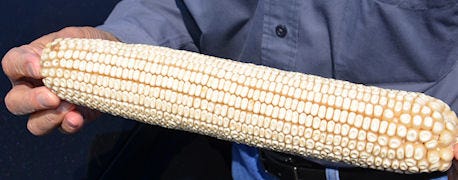
Dave Nanda pulled an ear of corn out of his car to show me that was more than a foot long. It was 54 kernels in length and had 20 rows of kernels around the ear. Is it the answer to 300 bushel per acre corn?
"No, not hardly," says Dave Nanda, a long-time plant breeder and director of genetics and technology for Seed Consultants, Inc. "Instead, it makes the case as to why what it takes to get high corn yields today are more ears, but shorter ears that a plant can hold onto and deliver for harvest."
Related: Huge Corn Yields Revive Interest in Pushing Yield Potential

Long ear: This ear has 54 kernels per row. While that's impressive, it's not the path to 300 bushel corn, Dave Nanda says.
This ear was even filled to the tip. Every last potential kernel pollinated and developed. But an ear can only hold so many kernels, Nanda says. At some point there is a physical limit to length and number of rows you can squeeze around a cob.
The ear Nanda showed me was actually open-pollinated Reid's yellow dent corn. A farmer who grows it for a hobby had given him the ear recently. The stand was equal to about 10,000 ears per acre.
Related: 7 Ways to Harvest Huge Corn Yields
There was a time about 30 years ago when plant breeders spent a considerable amount of energy trying to breed long ears from synthetic lines and also ears with more kernels per row. Synthetic lines are developed by concentrating genes for these particular traits into one plant.
In the end, those who bred for yield and other good traits using current germplasm came up with hybrids that yielded more corn per acre under most conditions, Nanda says. Corn has tremendous genetic diversity, and while it's important, the critical thing is finding inbred lines to make hybrids that produce many ears per acre that are good-sized ears, but not giant ears.
"More yield will come from more ears per acre in the future," he concludes.
About the Author(s)
You May Also Like




